Battle for hungary
By the end of September 1944, the 2nd Ukrainian Front under the command of Rodion Malinovsky was opposed by Army Group South (it was created instead of the former Army Group South Ukraine) and part of Army Group F. A total of 32 divisions (including 4 tank, 2 motorized and 3 cavalry) and 5 brigades (3 infantry and 2 tank). German troops had about 3,5 thousand guns and mortars, about 300 tanks, assault guns and 550 aircraft.
The 2nd Ukrainian Front included the 40th, 7th Guards, 27th, 53rd and 46th armies, the 6th Guards Tank and 5th Air Armies, 2 horse-drawn mechanized groups and 18 1st tank corps. Two Romanian combined arms armies (4st and XNUMXth), a volunteer division named after Tudor Vladimirirescu and a Romanian one also subordinated to the Soviet front aviation body. This group included: 40 rifle divisions, 17 Romanian infantry divisions, 2 fortified areas, 3 tank, 2 mechanized and 3 cavalry corps, 10,2 thousand guns and mortars, 750 tanks and self-propelled guns, more than 1,1 thousand aircraft.
According to the Supreme Headquarters, the main objective of the Soviet troops on the southern wing of the Soviet-German front (the 2 and 4 of the Ukrainian fronts) was the liberation of Hungary and Transylvania and the withdrawal of Hungary from the war. Thus, the prerequisites were created for the Red Army to reach the borders of Austria, the southern regions of Czechoslovakia, and the threat of southern Germany appeared. The troops of the 2 of the Ukrainian Front were to defeat the enemy's Debrecen grouping (6 of the German and 3 of the Hungarian armies) and free Northern Transylvania (by breaking the 8 of the German and 2 of the Hungarian armies). In addition, the armies of Malinowski were to go to the rear of the Carpathian grouping (1-I German tank and 1-I Hungarian army), assisting the 4-th Ukrainian Front and the 38-th Army of the 1-th Ukrainian Front on the Carpathians.
The front command decided to deliver the main blow in the center on the Debrecen direction, along the lines of Oradea, Debrecen, Nyiregyhaza. The shock grouping of the front included: 53-I army commanded by Ivan Managarov, 6-I Guards Tank Army of Andrei Kravchenko and cavalry-mechanized group (KMG) Issa Pliev (2 cavalry and 1 mechanized corps). The 46-I army under the command of Ivan Shlyomin and the 1-I Romanian army of corps general V. Atanasiu attacked the left wing of the front. The left wing of the front was advancing on the territory of Yugoslavia in the Seged direction, and it was supposed to occupy a bridgehead on the right bank of the Tissa River. On the right wing, 40-i was under the command of Philip Zhmachenko (on the Siget direction) and 7-I Guards Army of Mikhail Shumilov (in the direction of Dej and Satu-Mare) and Sergey Trofimenko's 27-I army (Cluj direction). The Romanian 4 Army of Corps General G. Avramescu and the cavalry-mechanized group of Lieutenant General S.I. Gorshkov (1 Tank and 1 Cavalry Corps) were also located here. Later, part of the forces of the right wing were transferred to the central sector.
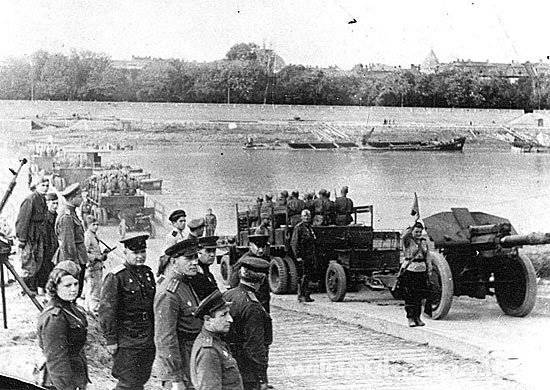
Crossing Tissu
On the eve of the operation, in the second half of September, 1944, Soviet long-range aviation delivered heavy blows at important railway junctions, bridges, warehouses and other objects on Hungarian territory. Aviation also attacked Budapest, Satu Mare, Debrecen and other Hungarian centers. The offensive began on October 6 with short but strong artillery and aviation training. Soviet artillery and aviation attacked enemy positions, fortifications, firing points and rear areas.
In the Debrecen area, Soviet troops almost immediately achieved significant success. On the very first day of the 6-I offensive, the Guards Tank Army and part of the forces of the 27 Army advanced to a depth of 20 km. In this case, the Soviet troops had to repel the fierce counterattacks of the enemy in the area between Oradea and Salonta. However, with the transition to the offensive of the troops of Managarov and Pliev on Elek and Kartsag and on the left wing of the front of the 46 Army of Schlemin on Subotica and Szeged, the resistance of the Hungarian army was broken. The 53 Army of Managarov and KMG Pliev, with the support of General SK Goryunov’s 5 Air Army, defeated the Hungarian 3. The Soviet troops not only broke through the enemy defenses, but in three days advanced to 100 kilometers, moving into the Kartsag area. The equestrian mechanized group of Pliev on October 8 reached the south-western approaches to Debrecen. On the same day, Soviet troops forced Tissa and captured a number of bridgeheads.
Thus, as a result of the breakthrough of the front and the rapid onset of the Soviet troops, the enemy's Debrecen grouping was swept from the west, which created a threat of encirclement and complete destruction of the German-Hungarian armies in Transylvania and worsened their position on the Carpathian line. The German command ordered the withdrawal of troops. Pursued by the 40, 27 and 4 units of the Romanian armies, the German-Hungarian troops retreated in the direction of Nyiregyhazu.
The German command, in order to ensure the withdrawal of armies and close a breach in the defense, threw considerable additional and reserve forces and means into battle. Particular attention was given to the turn of Oradea - Debrecen. Already the 8 of October and the Kartsag area struck a counterattack from the German 3-I tank division. On October 18, the 24 Tank Division and the 4 SS Motorized Division were thrown into battle. In general, the German command concentrated 13 divisions, including 5 armored and motorized. In turn, the front command reinforced the main strike grouping with the help of compounds transferred from the right flank, from the Regin-Turd area - the 7 Guards Army and the cavalry-mechanized Gorshkov group.
During the fierce battle, overcoming the stubborn resistance of the enemy, October 12 Soviet troops took Oradea, October 20 - Debrecen. Developing an advance to the north, the cavalry of Pliev 21 of October broke into the city of Nyiregyhaza. The advanced Soviet units reached the Tissu River, cutting off the German-Hungarian troops. As a result, the German command, in order to eliminate the threat of encirclement, had to organize a strong counterattack by three army and one tank corps. German troops were able to intercept communications KMG Pliev. On October 27, Pliev’s troops left Nyiregyhaza and retreated to the main forces of the 2 of the Ukrainian Front.
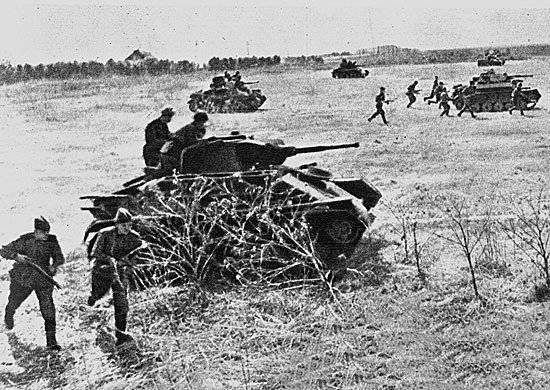
Soviet offensive on Szeged (Hungary). October 1944
By this time, the divisions of the 53 and 7 of the Guards armies reached the Tisza in the Szolnok-Polgar sector. On the left flank, units of the 46 Army of Schlemin occupied a major foothold on the Tisza, reached the Danube near the city of Baya and to the south. On the right flank of the front, the 40-I, 4-I Romanian and 27-I armies advanced to 20-110 km by the evening of October and 120 crossed Hungary's border a few days later. Thus, the armies of the 2 of the Ukrainian Front on the left flank forced Tissa and occupied a large bridgehead, in the center on a broad front reached the river, and on the right flank came close to the river.
The operation was successful, although it did not solve the main task. Hungary failed to withdraw from the war. The troops of 2 of the Ukrainian Front defeated the enemy's Debrecen grouping, advanced in various sectors on 130 - 275 km and occupied a large foothold on the Tissa River, creating the conditions for a decisive attack on the Budapest direction. In the course of the offensive battles, Northern Transylvania eastern regions of Hungary were liberated. German-Hungarian troops suffered a heavy defeat, losing only prisoners more than 40 thousand people. In addition, the plans of the German command to create a stable line of defense along the line of the Transylvanian Alps were thwarted. German-Hungarian troops retreated to the Hungarian Plain.
The importance of the 2 operation of the Ukrainian Front was that the emergence of the main forces of the Malinovsky front to the rear of the Carpathian enemy grouping created a serious threat to the German-Hungarian troops at the Carpathian border and played a decisive role in the liberation of Transcarpathian Russia. In mid-October 1944, the German command began to withdraw troops in front of the center and the left wing of the 4 of the Ukrainian Front. This allowed the troops of the 4 of the Ukrainian Front, who had previously gotten stuck on the enemy’s powerful Carpathian line, to pursue the enemy and successfully complete the Carpathian-Uzhgorod operation, freeing Mukachevo and Uzhgorod. Transcarpathian Rus (Ukraine) became part of Soviet Ukraine, and the reunification of the Russian lands was completed.
In addition, under the influence of the Debrecen operation, the political situation in Hungary changed. In the Hungarian army desertion intensified and the transition to the side of the Soviet troops. And the Horthy regime intensified negotiations with Britain and the United States, went to conclude an armistice with the USSR. True, this political process did not end in success. Horthy shifted and replaced by the right-wing radical Salashi, who continued the war to the end. Additional German forces entered Hungary.
Budapest operation (29 October 1944 - February 13 1945)
The attack on Budapest began almost without a pause. Already on October 29, the troops of the 2 of the Ukrainian Front attacked the enemy. The operation involved the troops of the 2 of the Ukrainian Front and the formation of the 3 of the Ukrainian Front under the command of Marshal of the Soviet Union Fyodor Tolbukhin. Tolbukhina troops just completed the Belgrade operation (Belgrade operation) and regrouped in Hungary to participate in the attack on Budapest.
The headquarters set the task of striking with the aim of encircling and defeating the enemy's Budapest group, liberating the Hungarian capital, in order to bring Hungary out of the war, and create the prerequisites for the liberation of Czechoslovakia and Austria. The main blow was inflicted on the left wing of the 2 of the Ukrainian Front by the 46 Army of Schlemin reinforced by the 2 and 4 Guards mekhkorpusi. The army of Schlemin was advancing south-east of Budapest, bypassing the city and was to take the Hungarian capital. The 7-I Guards Army of Shumilov and 6-I Guards Tank Army of Kravchenko delivered the second strike from the region to the northeast of the city of Szolnok. She had to go around Budapest from the northeast. The remaining front forces received the task of chaining the enemy troops in the center and on the far right flank, advancing in the direction of Miskolc. The troops of 3 of the Ukrainian Front, after completing the concentration of forces in the Banat region, were to take bridgeheads on the right bank of the Danube in Hungary and develop an offensive to the west and north.
The Soviet army was opposed by Army Group South and the Hungarian army. The German-Hungarian armies relied on a powerful Budapest fortified area and three defense lines. Adolf Hitler attached great importance to Hungary. Here are the latest sources of oil. He even stated that he would rather give up Berlin than Hungarian oil and Austria. Therefore, in Hungary, powerful mobile units were concentrated, including selected SS troops. In Hungary, the Germans and Hungarians were going to stop the Soviet armies, not to let them go further.
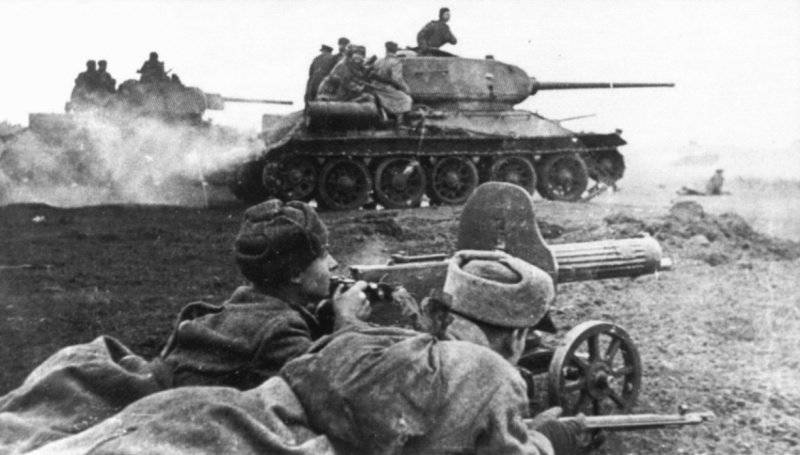
Divisions of tanks and infantry of the 2 of the Ukrainian Front on the approaches to Budapest
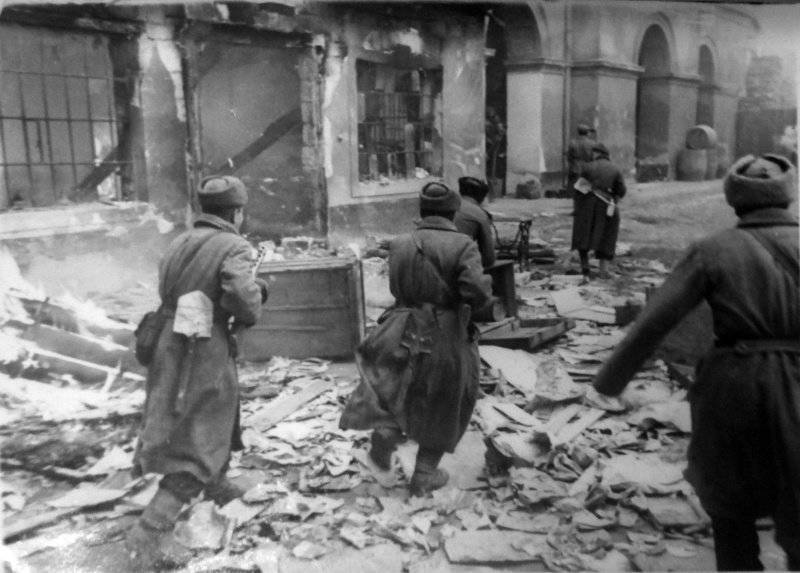
Soviet assault group of Lieutenant LS Brynina in a street fight in Budapest
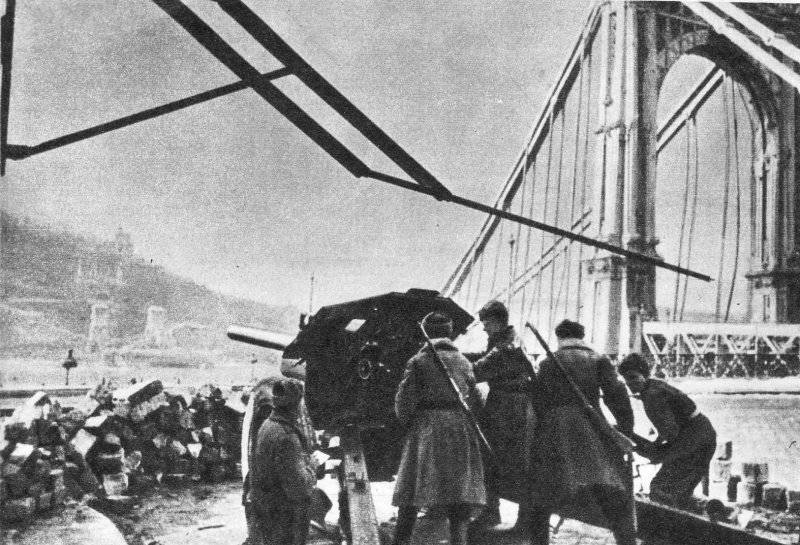
Calculation of the Soviet 122-mm howitzer M-30 in the battle for Budapest. On the right, the Erzhebet bridge blown up by German troops can be seen, connecting Buda and Pest.
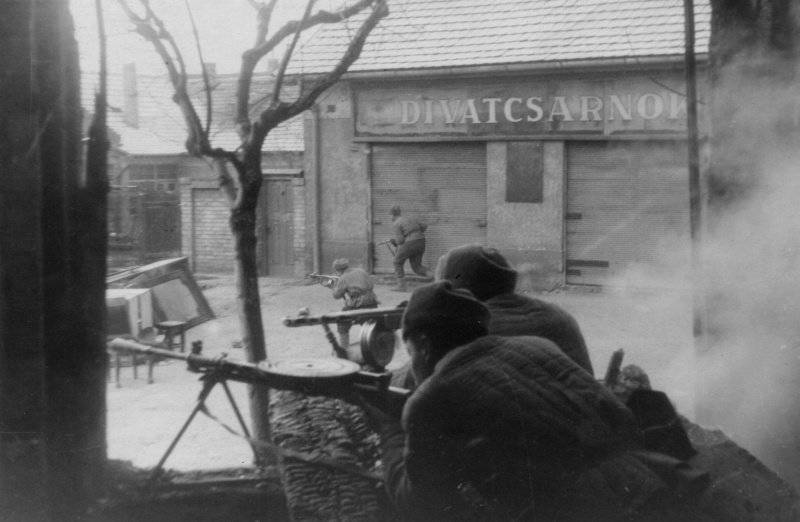
Fighters of the 3 of the Ukrainian Front in street battles for Budapest
The left wing of the 2 of the Ukrainian Front broke through the enemy defenses in the Budapest sector, where the Hungarian forces mostly defended themselves, and on November 2 came from the south to the nearest approaches to Budapest. However, it was not possible to take the city. The German command redeployed 14 divisions (including 3 tank and one motorized divisions) to the Hungarian capital and, relying on previously equipped strong fortifications, stopped the Soviet offensive. The Soviet command suspended the attack on the Budapest direction and continued it on other sectors of the front. During the stubborn battles of 11-26 in November, Soviet troops broke through the enemy defenses between Tisa and the Danube and advanced north-west for 100 kilometers. Soviet troops reached the outer defensive perimeter of the Hungarian capital.
December 5 troops of the center and the left wing of the 2-th Ukrainian Front resumed the attack on Budapest. Parts of the 7 Guards, 6 Guards Tank Army and the mechanized Pliyev cavalry group went to the Danube north of Budapest by 9 December. As a result of the enemy's Budapest grouping, the escape routes to the north were cut off. On the left flank, the 46-I army of Schlemin crossed the Danube south of Budapest. However, the Soviet troops could not take Budapest this time. The Germans and Hungarians stopped the Soviet troops on the "line Margarita". The German command, having in the area of Budapest 250-thousand. the group, which relied on a strong system of fortifications, restrained the Soviet offensive. German and Hungarian troops put up fierce resistance, the battles took on an extremely stubborn character. The Soviet command did not have the correct data on the forces of the enemy (this was due to the shortcomings of intelligence) and could not correctly assess the enemy’s ability to resist. On the right wing of the 2 of the Ukrainian Front, Soviet troops occupied Miskolc and reached the Czechoslovak border.
At this time, the 3rd Ukrainian Front (three Soviet and one Bulgarian combined arms and one air army) joined the battles for Hungary. After the liberation of Belgrade, Soviet troops, with the support of the Danube flotilla, crossed the Danube, and advanced to the lakes Velenz and Balaton. Here they joined forces with the 2nd Ukrainian Front.
10-20 December 1944 The troops of the two fronts were preparing for a new offensive. The Soviet armies were supposed to complete the encirclement and destruction of the Budapest group by strikes from the north-east, east and south-west, and free the capital of Hungary. The troops of the two fronts, overcoming the fierce resistance of the enemy (German-Hungarian forces numbered 51 German and Hungarian divisions and 2 brigades, including 13 tank and motorized), came in converging directions and through 6 days of fierce battles united in the area of the city of Estergoma. German troops counterattacked, but were defeated. As a result, 50-60 km west of Budapest was surrounded by 188-thousand. enemy grouping.
To stop further bloodshed, the Soviet command sent parliamentarians with a proposal for surrender. The group of captain Ilya Ostapenko was sent to Buda, and the captain Miklos Steinmetz to Pest. The Germans killed the Soviet parliamentarians. Thus, Budapest, with its population of more than a million, was the fault of the German command and the government of Salash, who himself fled the city, was doomed to become the scene of a fierce battle in which thousands of civilians were killed. The German command was not going to give Hungary and continued to strengthen the group army "South". To retain Hungary, 37 divisions were redeployed, which were removed from the central sector (Berlin direction) of the Eastern Front and other directions. By the beginning of 1945, south of the Carpathians, 16 tank and motorized divisions were concentrated. It was half of all the armored forces of the German army on the Eastern Front. The Germans have never had such a density of tank forces in one direction on the Eastern Front.
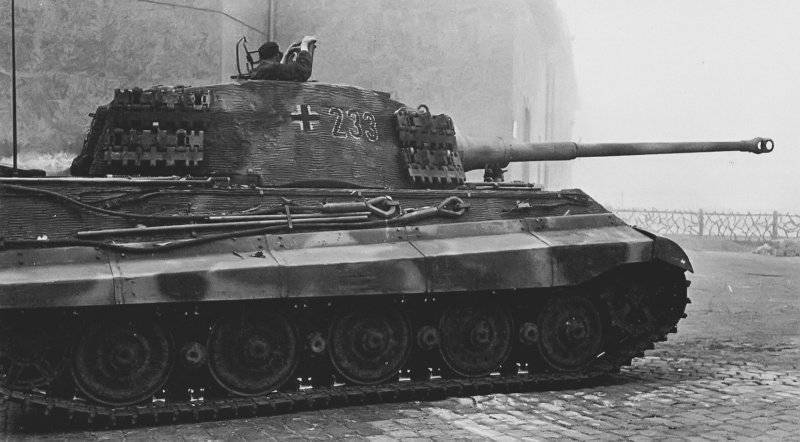
German heavy tank Pz.Kpfw.VI Ausf.B “Royal tiger” 503-th tank battalion in Budapest
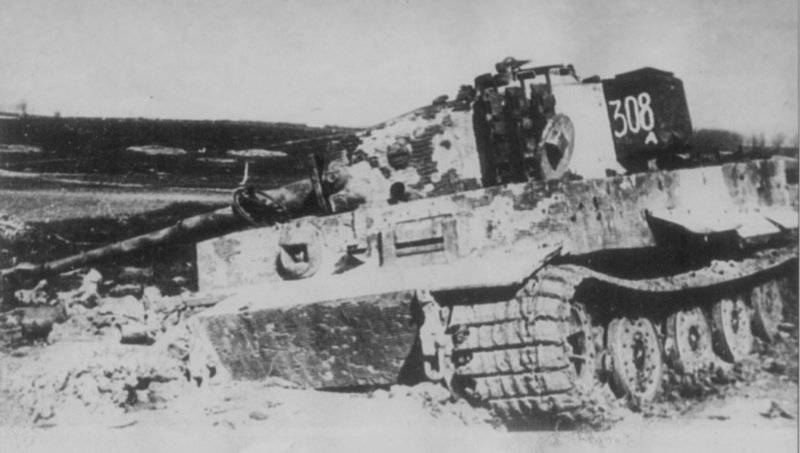
Downed and burned down heavy tank Pz.Kpfw. VI Ausf. E "Tiger" from the 3-th tank regiment of the 3-x SS Panzer Division "Dead Head". Lake Balaton area.
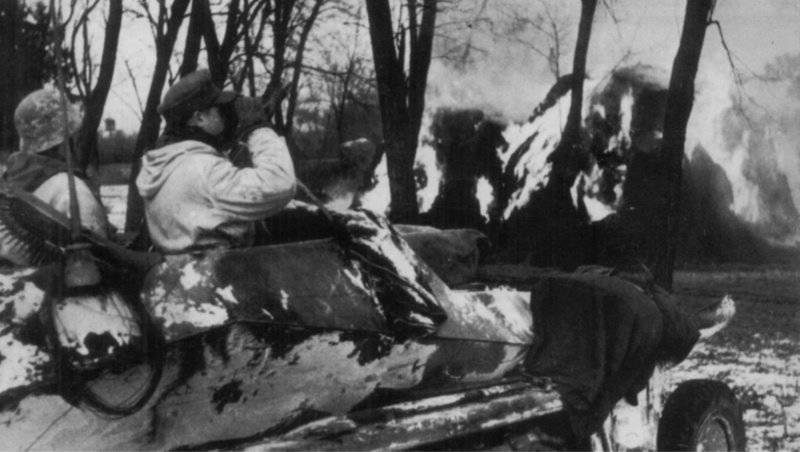
German pancergrenadiers on the Bd Sd.Kfz. 251 in the attack on the position of the Soviet troops
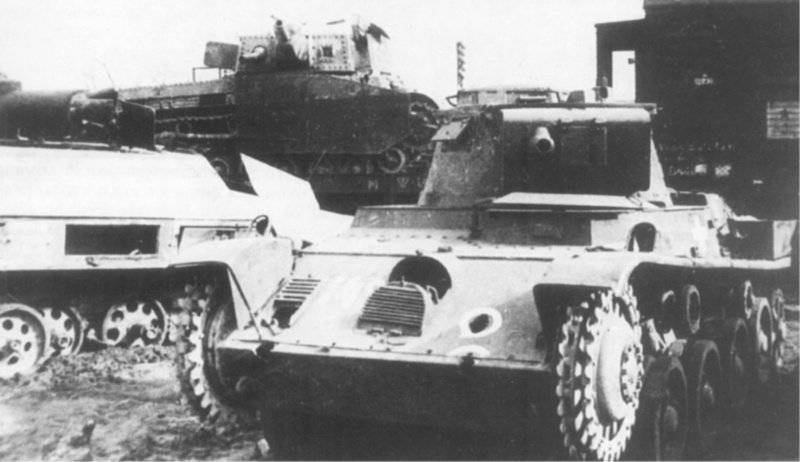
The wounded Hungarian light tank 38M "Toldi I" from the 2 th Hungarian Tank Division defeated in Budapest. On the railway platform - Hungarian medium tank 41M Turan II
In Hungary, fierce fighting continued. The German command tried to unlock the surrounded Budapest group with strong counterattacks. German-Hungarian troops launched three strong counterattacks. In some cases, the 1 km breakout area accounted for 50-60 German tanks. 2-6 January 1945 German troops advanced along the right bank of the Danube on 30-40 km. Particularly powerful was the January 18-26 offensive (third counterstrike) from the region north of Lake Balaton. The Germans were able to temporarily dismember 3-th Ukrainian Front and go to the west bank of the Danube.
To stop the enemy’s offensive, the commander of the 3 Ukrainian Front, Marshal Tolbukhin, applied the experience of the Battle of Kursk. The Soviet troops in the shortest possible time have created a defense in depth to the depth of 25 — 50 km. A great role was played by intelligence, which timely uncovered the movement of the enemy forces, as well as artillery and aviation, which made preemptive strikes in threatened areas. By joint efforts of the troops of the 3 and 2 of the Ukrainian fronts, the enemy’s breakthrough was eliminated. By the beginning of February, the front was stabilized, the Germans had exhausted their offensive capabilities.
At a time when German troops tried to unblock the Budapest group, part of the forces of the 2 of the Ukrainian Front were a specially created Budapest group of troops under the command of Lieutenant General Ivan Afonin, and the field of his injury, Ivan Managarov (3 rifle corps, 9 artillery brigade), stormed Budapest. The fights were stubborn. Only January 18 took the eastern part of the city - Pest, and February 13 - I would. At 140, thousands of enemy soldiers and officers were captured.
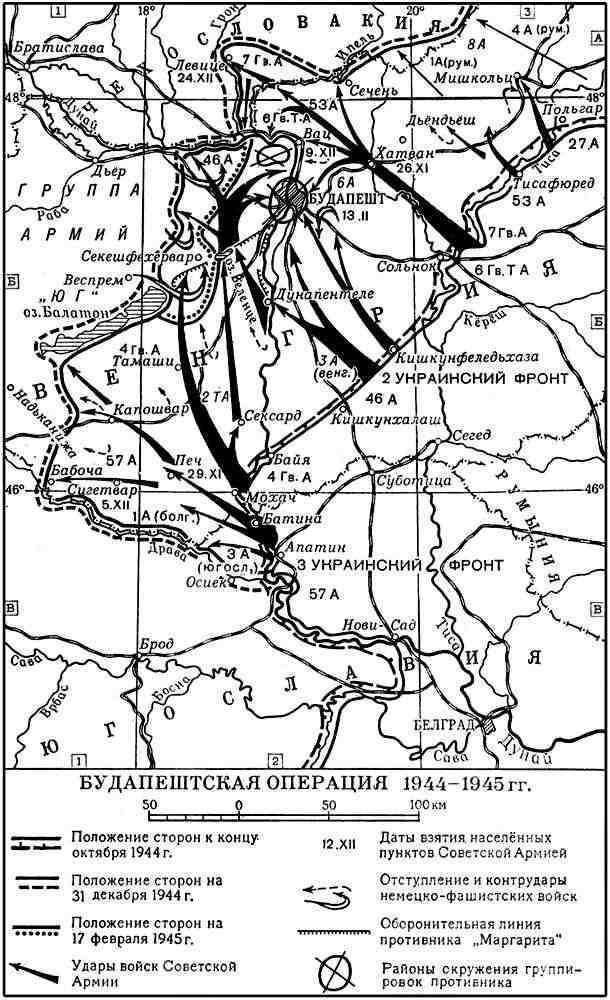
Results of the operation
Soviet troops surrounded and destroyed an almost 190-thousandth enemy group, liberated two-thirds of the country and stormed Budapest. During the long battle (108 days), 40 divisions and 3 brigades were crushed, 8 divisions and 5 brigades were completely destroyed.
The successful completion of the Budapest operation radically changed the entire strategic situation on the southern wing of the Soviet-German front. The southern flank of the German armed forces was deeply enveloped. The German command was forced to speed up the withdrawal of troops from Yugoslavia. The troops of the 2 and 3 of the Ukrainian fronts created the conditions for the liberation of Czechoslovakia and the attack on Vienna.
December 22 was formed by the Provisional Government of Hungary. 28 December The Provisional Government announced the withdrawal of the country from the war on the side of Germany. Hungary declared war on Germany. 20 January 1945, the Hungarian delegation in Moscow signed an armistice agreement. The liberation of Hungary by Soviet troops thwarted the plans of London and Washington to use the Hungarian territory to their advantage.
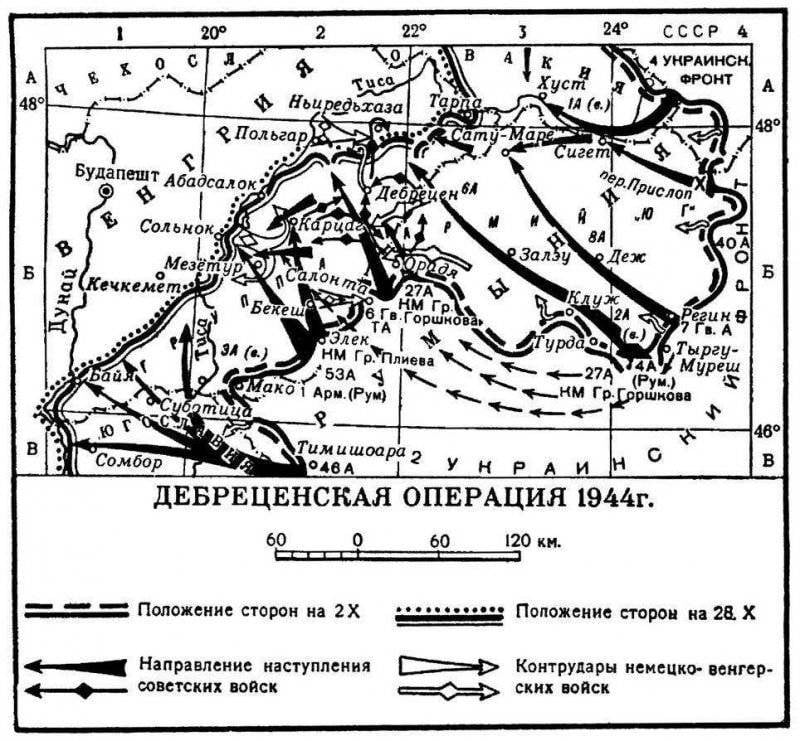
Information